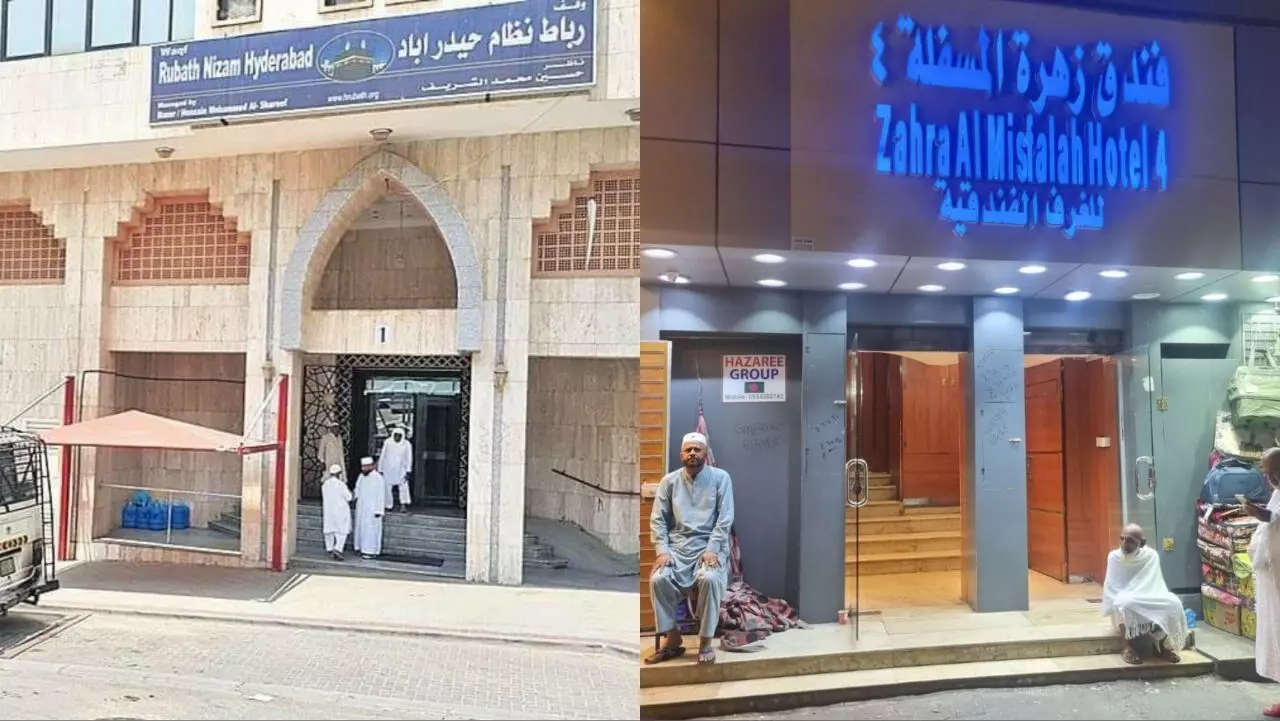How Rubat properties were gobbled up in Saudi Arabia
It is believed that the first time such kind of residential facilities were established in Makkah and Madina by an outside ruler was V Nizam Mir Tahniat Ali Khan popularly known as Afzal-ud-Daula in 1860
By Newsmeter Network
From left: Rubath free housing facility (Before and After)
Hyderabad: Before the discovery of oil, the entire Gulf region was reeling under a pecuniary crisis. Saudi Arabia was also not able to provide better facilities to the guests of Almighty who arrived for the Haj pilgrimage.
A few Indian rulers like Nizams of Hyderabad and Nawabs of Bhopal, Arcot, and Tonk had established free housing facilities in Makkah and Madina for pilgrims belonging to their territorial areas, which were called ‘Rubath’ or ‘Rubat’.
It is believed that the first time such kind of residential facilities were established in Makkah and Madina by an outside ruler was V Nizam Mir Tahniat Ali Khan popularly known as Afzal-ud-Daula in 1860. Though it is said that he bought houses and land sites there and established 42 Rubat, however, documentary evidence is almost extinct to prove this claim.
Even the Nizams’ Auqaf Committee, Waqf Board, or Haj Committee is not in a position to present supporting documents. None of these Rubats except two or three, which were built by Asaf Jahi Rulers, exists in Makkah or Madina. All of these properties vanished over the course of time with the expansion of the Grand Mosque and the development of the holy city of Makkah. They haven’t even a complete list of such Rubats. When enquired with the officials of the State Archives, it is revealed that only a few futile papers have been traced in the past.
After the demise of Mir Osman Ali Khan, neither his successor Prince Mukarram Jah Bahadur nor Nizam’s Auqaf Trust showed interest in the protection of these properties Many people came forward to claim their rights on the property. Due to insignificant cooperation from the Nizam Auqaf Trust and delay in providing documentary evidence to claim the title, only a few properties could be retained and registered again as Waqf.
In King Faisal bin Abdul-Aziz Aal Saud’s rule, Saudi authorities had taken a policy decision that any property belonging to a foreign national in Saudi Arabia had to be registered either as Waqf General (To be run by Saudi Authorities) or Waqf (Private) to be run by an appointed Nazer (administrator) who should be a Saudi National, otherwise, it should be sold within a set deadline. At that time last Nizam Mir Osman Ali Khan had appointed Shareef Mohammed advocate who was not only a Saudi National with a lineage link in Hyderabad.
After the discovery of oil, the Kingdom's rulers developed Makkah City and expanded Grand Mosque and this process is in progress even today. Some people believed that the Saudi government had acquired those Rubats by providing sufficient compensation during the expansions, and a huge amount was deposited in the banks by the local authorities. The amount was not disbursed due to the nature of these properties i.e. Waqf. There is a divine principle that ‘once a Waqf always Waqf’ and even the Waqif (endower) has a right to revoke nature or change the purpose of Waqf.
On information about acquiring Nizam’s properties in the holy place and depositing a huge amount by the Saudi authorities in lieu of acquired properties purchased by Nizams, Nizam Auqaf Trust had sent two people successively from Hyderabad to KSA on behalf of Prince Mukarram Jah Bahadur to represent the Nizam’s Auqaf Trust and claim the deposit amount which was kept in Saudi Banks.
Astonishingly, neither Nizams Auqaf Trust nor the Nazer of Rubat ever considered it appropriate to inform the people of Hyderabad or the government about the compensation deposited by the KSA government, which raises doubts that Nizam’s Auqaf Trust and Nazer of the Rubats colluded and shared the compensation amount among them.
That is the reason Trust office bearers never informed the public about the disappearing of properties, compensation amount, or disputes between Nazer and Trust. They did not object to the refusal of accommodation in Rubat last year and this year by the Nazer. The office-bearers of the Trust have not objected to converting the Rubat into a lodge.
The official website of Rubat https://www.hrubath.org/ shows an announcement on its home page stating: ‘’2023 shall be the phase of re-designing the operations of RUBATH to better utilization, considering the Post Covid effect ( Expenses incurred ) and the expansion of the Makkah City Master Plan.
Inshallah by 2024, Rubath Nizam Hyderabad is expected to start effective Ramadan with better service and increased and efficient utilization of space to accommodate more guests.
The inconvenience of 2023 not being able to accommodate, is highly regretted, and expect all to pray to Almighty to empower the NAZER/Hussain Al Shareef to do what is best in the interest of the Guests of Allah coming from Nizam State.’’
Not satisfied with the explanation given by the Nazer of Rubat, intending pilgrims and Hyderabadis are calling it an eyewash. Earlier Nazer of Rubat and Trust people misled the people stating that the Municipal authorities of Makkah are not issuing permits to run Rubat as the building as it does not fulfill the criteria laid down by the civic authority and that the building falls under the expansion project of the Grand Mosque.
They also questioned how the civic body granted a permit to run a lodge to the same premises. It convinces us that there is something fishy going on.